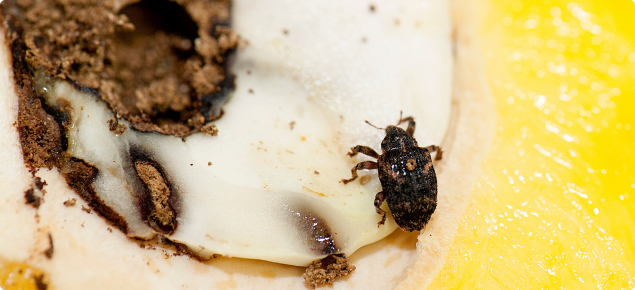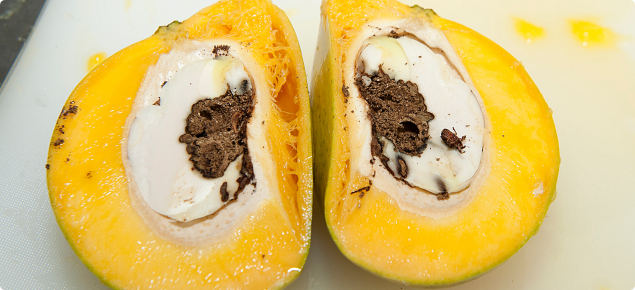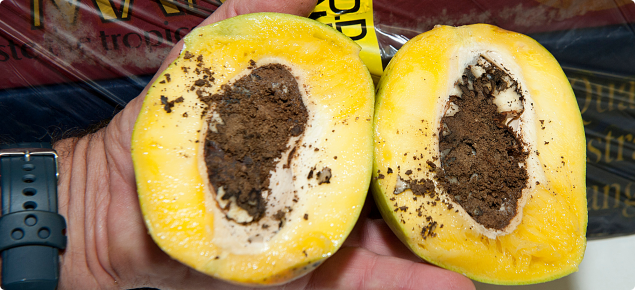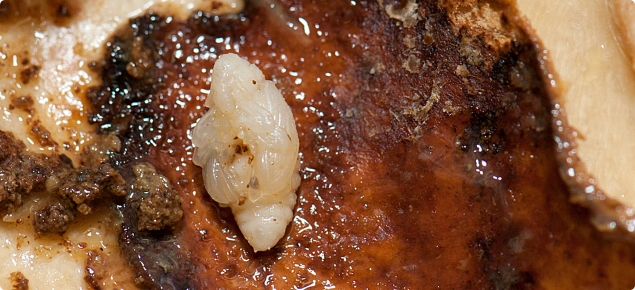Preferred scientific name
Sternochetus mangiferae (Fabricius 1775) [Coleoptera: Curculionidae]
Synonyms
Cryptorhynchus ineffectus Walker 1859
Cryptorhynchus mangiferae (Fabricius 1775)
Cryptorhynchus monachus Boisduval 1835
Curculio mangiferae Fabricius 1775
Rhynchaenus mangiferae (Fabricius 1775)
Preferred common name
Mango seed weevil
Alternative common names
Mango stone weevil
Mango nut weevil
Mango weevil
Common host plants
Mango (Mangifera indica).
Plant part affected
Fruit and seed
Australian distribution
Queensland
New South Wales
Northern Territory (Peng & Christian 2007).
Status in Western Australia
Sternochetus mangiferae (Fabricius, 1775) is considered to be absent from Western Australia and is a quarantine pest. It is a prohibited organism under section 12 of the Biosecurity and Agriculture Management Act 2007.
To confirm the current status please check the Western Australian Organism List. For more information on prohibited organisms please see frequently asked questions about the BAM Act and WAOL.
Biology and ecology
The biology and ecology of mango seed weevil has been adapted from CABI (2015) and modified to include information relevant to Western Australia. A diagnostic protocol for Sternochetus mangiferae is described in EPPO (2011).
The adult mango seed weevil is an oval-shaped beetle, 7.5–10mm long; with an elongated head that forms a snout. They are dark brown with mottled markings on the wing covers.
Most of their lifecycle is spent as resting adults, where the young weevils emerge from the mango fruit and enter a suspended animation stage (diapause) during non-fruiting periods. Diapausing weevils can be found under loose bark on mango tree trunks, in branch crevices and other crevices near mango trees.
In the Northern Territory, adults emerging November to mid-December enter a diapause from December to mid-August. The onset of diapause seems to be associated with long-day photoperiod, and the break with short-day photoperiod.
When mango fruits are developed to ‘pea size’ (0.5–1 cm diameter) the adults become active and begin feeding on leaves and tender shoots of mangoes and commence mating. They are nocturnal, readily disturbed, and usually feed, mate and lay eggs from late afternoon to dusk.
Females begin to lay eggs 3–4 days after mating, and are capable of laying 15 eggs per day; from mid-August to early October in the Northern Territory. Small to medium-sized fruits are preferred, but full grown fruit may also be attacked.
The female makes a shallow, boat-shaped depression in the fruit rind, lays a single egg in the depression, and covers it with a brown secretion. She then cuts a crescent-shaped area in the fruit near the posterior end of the egg, creating a sap flow which solidifies and covers the egg with a protective opaque coating.
Eggs hatch in 5–7 days, depending on season and temperature. After hatching, the small larva burrows through the pulp to the young developing seed. Larval development usually occurs within the seed and only very rarely in the pulp. Generally, only one larva develops in a seed, but as many as five have been found.
As the mango fruit and seed develop, the tunnel and seed entry wounds are completely absorbed making it impossible to distinguish between infested and non-infested seeds unless they are cut open.
In the Northern Territory the larval period is from late August to early October, taking about 40 days to develop. The duration of the larval period may be influenced by climate, location, host cultivar, and non-biotic site characteristics (e.g. soil chemistry, humidity, etc.) (Hansen et al. 1989).
The larvae excavate cavities within the seed and pupate. The neonate adult will cut its way out of the naked seed generally four to eight weeks after the fruit falls and decays. On rare occasions weevils emerge from the seed before fruit fall and eat their way through the flesh of ripe fruit, ruining it completely.
In the Northern Territory, the larvae, pupae and adult seed weevils stay in mango seeds for about 90 days (mid-August to mid-November) (Peng & Christian 2007).
When the adults emerge, they rapidly move out of the seeds and seek hiding places by crawling, rather than flying, and remain in sheltered places close to the parent tree until the following fruiting season. Mango weevils possess well-developed wings but are poor fliers and fly only 50 to 90cm at a time (Grové et al. 2007). The limited natural dispersal of the weevil means that high infestations appear year after year in some locations while infestations in nearby trees remain low.
Mango seed weevil has limited capacity for natural dispersal. Its extensive global distribution is attributed to the trade of infested fruit and seed.
Economic consequences
Mango seed weevil is one of the most important quarantine pests for commercial mango crops. Because the mango seed weevil is a quarantine pest, some large mango-importing countries, including the USA, China, Japan and some Arabian Gulf countries, impose quarantine restrictions on the importation of mango fruit from infested areas (Peng & Christian 2007).
Damage caused by mango seed weevil may result in fruits being downgraded (Peng & Christian 2005; 2007), reduction in yield from premature fruit drop (Verghese et al. 2005) and reduction in seed viability for seedling production (Follett & Gabbard 2000).
What do I do if I find it?
Sternochetus mangiferae (Fabricius, 1775) is a prohibited organism for Western Australia. It is important that any suspect infestations are reported. Early detection and eradication will help protect the Western Australian mango industry. Please contact the Pest and Disease Information Service (PaDIS) to report this pest.
References
CABI 2015, Sternochetus mangiferae (mango seed weevil) [original text by R Peng], Invasive Species Compendium [online database]. CAB International (CABI), Wallingford, UK. <http://www.cabi.org/isc/datasheet/16434> [22 June 2015].
EPPO 2011, Sternochetus mangiferae. EPPO Bulletin, 41: 352–356.
Follett PA & Gabbard Z 2000, Effect of mango weevil (Coleoptera: Curculionidae) damage on mango seed viability in Hawaii. Journal of Economic Entomology, 93: 1237–1240.
Grové T, Joubert JP & de Beer MS 2007, Literature review on mango seed weevil, Sternochetus mangiferae (Fabricius) (Coleoptera: Curculionidae). SA Mango Growers' Association Research Journal, 27: 21–28.
Hansen JD, Armstrong JW & Brown SA 1989, The distribution and biological observations of the mango weevil, Cryptorhynchus mangiferae (Coleoptera: Curculionidae), in Hawaii. Proceedings, Hawaiian Entomological Society, 29: 31–39.
Peng R & Christian K 2005, Integrated pest management for mango orchards using green ants as a major component: A manual for conventional and organic mango growers in Australia. Northern Territory Government, Department of Primary Industry, Fisheries and Mines, Northern Territory.
Peng R & Christian K 2007, The effect of the weaver ant, Oecophylla smaragdina (Hymenoptera: Formicidae), on the mango seed weevil, Sternochetus mangiferae (Coleoptera: Curculionidae), in mango orchards in the Northern Territory of Australia. International Journal of Pest Management, 53: 15-24.
Verghese A, Nagaraju DK, Kamala Jayanthi PD & Madhura HS 2005, Association of mango stone weevil, Sternochetus mangiferae (Fabricius) (Coleoptera: Curculionidae) with fruit drop in mango. Crop Protection, 24: 479–481.





